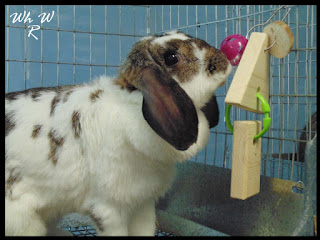Monday, July 21, 2014
Tuesday, July 15, 2014
Feeding your Rabbit
Feeding:
1. Have fresh water available at all times. Some rabbits prefer water bottles while some prefer bowls. For those that use bowls I recommend the Lock N Crock style bowls that attach to the side of the cage and help prevents spilling. A water bottle that we are pleased with is the Lixit brand water bottles.
2. Have pellet food available at all times until 6 months old. We feed our rabbits Kent Top Show rabbit feed. If you are interested in keeping your rabbit on this feed, visit this link to find a dealer in your area: KENT DEALER. A suggested amount of feed for full grown Mini Lops is 1/2 cup - 2/3 cup a day.
3. Provide a handful of hay each morning. I recommend Timothy Hay or Orchard Grass Hay. You can find hay available at a much more affordable price at Farm Supply stores such as Rural King or Tractor Supply. Hay in pet stores or department stores in the pet section is much more expensive. You may also be able to find a good source of fresh hay on craigslist from local farmers. *If someone in your family is allergic to hay then it would be acceptable to only feed your rabbit pellet feed. Otherwise please include some hay in the diet.
Keeping their teeth down:
Rabbits teeth continually grow thus they need to chew things to help keep them them from becoming overgrown. You can buy safe rabbit chew toys at any pet store. Some other options that are natural and safe for them are the following: Apple tree, Poplar, or Willow twigs, raspberry or blackberry canes, and rose bush stems. Please make sure they have not been sprayed with pesticides. They also enjoy chewing on and playing with cardboard paper towel or toilet paper rolls.
Our rabbits enjoy Critterz Chewzit Toys.
1. Have fresh water available at all times. Some rabbits prefer water bottles while some prefer bowls. For those that use bowls I recommend the Lock N Crock style bowls that attach to the side of the cage and help prevents spilling. A water bottle that we are pleased with is the Lixit brand water bottles.
2. Have pellet food available at all times until 6 months old. We feed our rabbits Kent Top Show rabbit feed. If you are interested in keeping your rabbit on this feed, visit this link to find a dealer in your area: KENT DEALER. A suggested amount of feed for full grown Mini Lops is 1/2 cup - 2/3 cup a day.
3. Provide a handful of hay each morning. I recommend Timothy Hay or Orchard Grass Hay. You can find hay available at a much more affordable price at Farm Supply stores such as Rural King or Tractor Supply. Hay in pet stores or department stores in the pet section is much more expensive. You may also be able to find a good source of fresh hay on craigslist from local farmers. *If someone in your family is allergic to hay then it would be acceptable to only feed your rabbit pellet feed. Otherwise please include some hay in the diet.
Keeping their teeth down:
Rabbits teeth continually grow thus they need to chew things to help keep them them from becoming overgrown. You can buy safe rabbit chew toys at any pet store. Some other options that are natural and safe for them are the following: Apple tree, Poplar, or Willow twigs, raspberry or blackberry canes, and rose bush stems. Please make sure they have not been sprayed with pesticides. They also enjoy chewing on and playing with cardboard paper towel or toilet paper rolls.
Our rabbits enjoy Critterz Chewzit Toys.
 |
| Lily with a Critterz Chewzit toy in her cage |
Housing your Rabbit
The first thing to decide is if you'll be housing your rabbit indoors or out.
If keeping your rabbit indoors:
You will need to purchase a suitable sized cage.
The cage needs to have enough room for a sleeping area, food and water, space to hop around, and a litter box if desired. There are both solid bottom cages, where I would suggest using a litter box, and wire bottom where the waste falls through to a tray below. Either can work, it's a matter of personal preference. I like the wire bottom cages personally. Not all rabbits use litter boxes well. If they don't, the wire bottom cage with tray underneath prevents them from getting soiled in their waste.
The following solid bottom cage would be an example of one that should provide adequate space for one Mini Lop when full grown.
Living World Deluxe Pet Habitat X Large
The following links show examples of wire bottom cages where the waste falls through to a tray below:
Mini Lop: KW 4000 Cage 30 x 30
or larger: KW 4000 Cage 36 x 30
Where to place your cage:
1. In an area that has good ventilation.
2. Do not place in direct sunlight or else your rabbit will overheat.
3. Do not place near electrical cords or other hazards.
4. Keep away from loud noises.
I also recommend a pet exercise pen. This will provide an area where your rabbit can run around and get more exercise without getting into mischief and chewing on anything it should not.
(If using outdoors realize your rabbit will be a target for hawks. Use only with close supervision and caution outdoors.)
If keeping your rabbit outdoors:
First you must purchase a suitable sized hutch.
The hutch needs to have enough room for a sleeping area, food and water dishes, space to hop around, and a litter box if desired. Please keep in mind your small 2 month old bunny will get much bigger.
It is important that the hutch is predator proof and provides some protection from adverse weather.
Where to place your hutch:
1. Not in direct sunlight. Shade is important.
They can handle cold weather better than hot weather.
2. Face opening away from wind & precipitation.
Tips in Summer:
1. If mid to upper 80’s provide frozen water bottles. They will lick them and lay next to them.
Tips in Winter:
1. Provide extra hay & newspaper for warmth.
2. Add extra insulation and protection to sides. For example: wood along inside walls if needed. Poly sheeting over sides and part of front to keep out wind and snow and keep in warmth. There does need to be some ventilation though.
3. Wrap the water bottle in bubble wrap to help keep from freezing as quickly. Make sure the nozzle on the water bottle is not frozen and blocking water from coming through. Another option is to use a lock n crock bowl for water. If you buy a couple then you can switch out with a unfrozen one as needed.
Keep in mind that despite that your rabbit will survive the cold relatively well you will need to go out and give your rabbit care and attention a couple times a day no matter how cold it is. So please consider how much you like going out in cold, winter weather before choosing to keep a rabbit outdoors.
We currently have all of our rabbits in an indoor rabbitry. However this photo shows our large outdoor hutch.
If keeping your rabbit indoors:
You will need to purchase a suitable sized cage.
The cage needs to have enough room for a sleeping area, food and water, space to hop around, and a litter box if desired. There are both solid bottom cages, where I would suggest using a litter box, and wire bottom where the waste falls through to a tray below. Either can work, it's a matter of personal preference. I like the wire bottom cages personally. Not all rabbits use litter boxes well. If they don't, the wire bottom cage with tray underneath prevents them from getting soiled in their waste.
The following solid bottom cage would be an example of one that should provide adequate space for one Mini Lop when full grown.
Living World Deluxe Pet Habitat X Large
The following links show examples of wire bottom cages where the waste falls through to a tray below:
Mini Lop: KW 4000 Cage 30 x 30
or larger: KW 4000 Cage 36 x 30
Where to place your cage:
1. In an area that has good ventilation.
2. Do not place in direct sunlight or else your rabbit will overheat.
3. Do not place near electrical cords or other hazards.
4. Keep away from loud noises.
I also recommend a pet exercise pen. This will provide an area where your rabbit can run around and get more exercise without getting into mischief and chewing on anything it should not.
(If using outdoors realize your rabbit will be a target for hawks. Use only with close supervision and caution outdoors.)
First you must purchase a suitable sized hutch.
The hutch needs to have enough room for a sleeping area, food and water dishes, space to hop around, and a litter box if desired. Please keep in mind your small 2 month old bunny will get much bigger.
It is important that the hutch is predator proof and provides some protection from adverse weather.
Where to place your hutch:
1. Not in direct sunlight. Shade is important.
They can handle cold weather better than hot weather.
2. Face opening away from wind & precipitation.
Tips in Summer:
1. If mid to upper 80’s provide frozen water bottles. They will lick them and lay next to them.
Tips in Winter:
1. Provide extra hay & newspaper for warmth.
2. Add extra insulation and protection to sides. For example: wood along inside walls if needed. Poly sheeting over sides and part of front to keep out wind and snow and keep in warmth. There does need to be some ventilation though.
3. Wrap the water bottle in bubble wrap to help keep from freezing as quickly. Make sure the nozzle on the water bottle is not frozen and blocking water from coming through. Another option is to use a lock n crock bowl for water. If you buy a couple then you can switch out with a unfrozen one as needed.
Keep in mind that despite that your rabbit will survive the cold relatively well you will need to go out and give your rabbit care and attention a couple times a day no matter how cold it is. So please consider how much you like going out in cold, winter weather before choosing to keep a rabbit outdoors.
We currently have all of our rabbits in an indoor rabbitry. However this photo shows our large outdoor hutch.
Subscribe to:
Posts (Atom)


